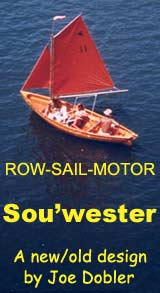
 Custom Search
|
| boat plans |
| canoe/kayak |
| electrical |
| epoxy/supplies |
| fasteners |
| gear |
| gift certificates |
| hardware |
| hatches/deckplates |
| media |
| paint/varnish |
| rope/line |
| rowing/sculling |
| sailmaking |
| sails |
| tools |
| join |
| home |
| indexes |
| classifieds |
| calendar |
| archives |
| about |
| links |
| Join Duckworks Get free newsletter CLICK HERE |
|
|
| How To Make A BHSB* |
by Erin Scott - Spokane, Washington
- USA |
*(Big Honkin’ Sandin’ Block) One day I put a brand new belt on my trusty 3x24 belt sander and got to work fairing some things out. Then I hit a snag, literally. I missed a screw that was still poking sharp point out and it cut my new belt into two small belts which then proceeded to slap me silly. After I got done throwing things and swearing, I put another new belt on and finished sanding. Later in the day I was cleaning up a bit and started to throw the ruined belt in the garbage and I decided I ought to find a way to use what remained. The BHSB is what I came up with, they’ve worked out so well that I make them with new unused belts now.
You are off and running. I’ve found that having a couple in different widths and grits makes short work of shaping and fairing things. Because the belt is under tension it stays nice and flat against the bottom board and doesn’t deflect or bunch up.
|
To comment on Duckworks articles, please visit one of the following:
|
 |










